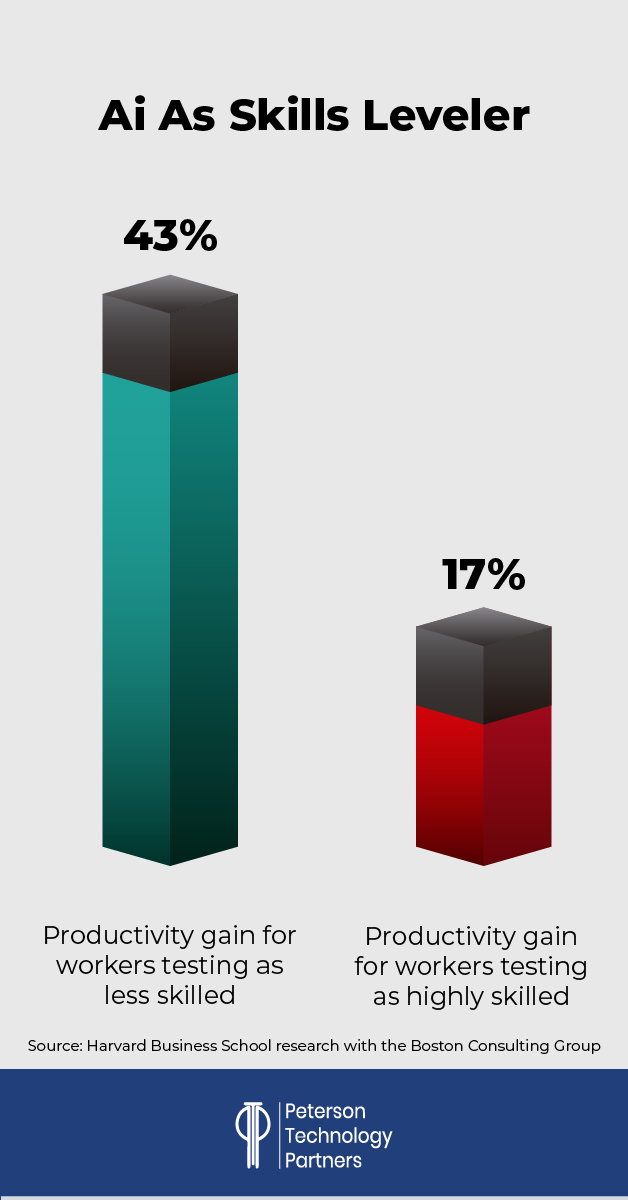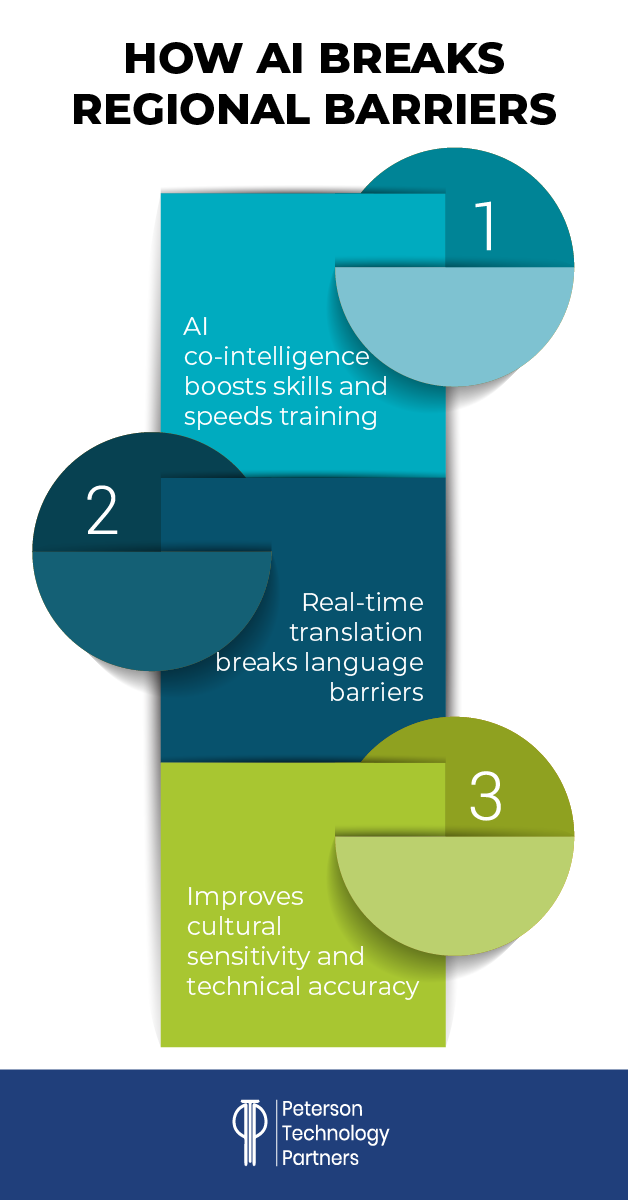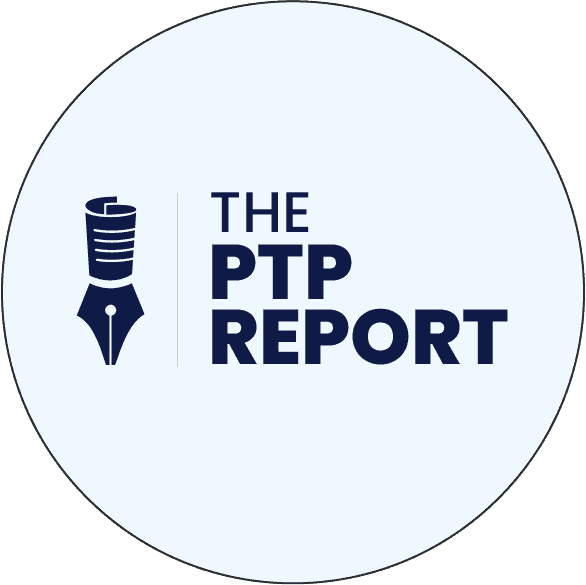AI use in the workplace is booming.
According to a Microsoft and LinkedIn poll, twice as many American workers say they’re using AI now vs 2023, with the following professions believing it most essential: product management (86%), consulting (69%), marketing (68%), IT, and HR (both at 61%).
Fittingly, more than half (52%) of US workers believe gaining AI skills will help them work.
Here at PTP, we believe they’re correct, and we’ll go further and say AI skills and experience may be essential for keeping pace with an increasingly AI-savvy global workforce.
Generative AI certainly isn’t perfect, but already it’s proving to be a great skills leveler, and also showing huge strides in helping bridge language barriers and assisting with cross-cultural sensitivities.
In today’s PTP Report we take a look at how, and the impact this is having on outsourcing, with studies that have assessed wage gaps vs productivity returns with the assistance of AI.
The Current Advantages in Onshore Recruiting
There have always been positions where people simply must be onsite, but for an increasingly large chunk of the workforce, the physical location where work gets done has become less important than the worker, and the quality of their work.
Onshore workers are still necessary in many roles for their language mastery, cultural affinity, unique skillsets, or even for security or regulatory purposes.
In such cases, offshore recruiting has traditionally not been an option.
The usual rule of thumb is that lower-cost, repetitive, or highly structured tasks are the best suited to be moved overseas, to take advantage of available workforce, lower wages, and follow-the-sun coverage (using time zones to your advantage). This includes customer support, data entry, IT maintenance, and many development tasks.
Inversely, things requiring real-time collaboration, handing sensitive data, or working at the frontier (like research and development), crisis or emergency related, or speaking directly to a cultural experience (as in communications, design, sales, marketing) have remained local by necessity.
All this is common sense, and yet current studies are showing this balance is already being upset by emerging AI solutions.
At Davos, one area where leadership across businesses found consensus was that AI is showing real productivity boosts, and that it may soon eliminate call centers altogether. HR departments, too, are finding many of their tasks automated.
And yet while this removes a large section of work that’s been traditionally offshored (or even brings it back onshore in a new way), what’s being offshored is also being shifted by improvements in AI.
The structure of global labor markets are being jockeyed, with many companies rethinking their long-held sourcing strategies.
AI as Skills Leveler
Automation is one thing shifting the workplace, but another is co-intelligence.
With newer reasoning solutions and agentic AI systems decreasing the need for sophisticated (or layered) prompting techniques, generative AI solutions are getting easier to use at the same time they’re increasing in sophistication.
But from the start, these systems have shown a tendency to help lower-skilled workers (and students) more dramatically than higher-skilled ones. In other words, as AI is itself getting more capable and smarter, it’s also raising the bar on the work that everyone can achieve, around the world and across cultural and language barriers.
Consider these findings from a study by the Harvard Business School and the Boston Consulting Group (and reported on by one of the researchers, Ethan Mollick, on his blog):

This study selected tasks meant to be realistic comps for the work done by top consulting firms, and found that workers using GPT-4 outperformed those that didn’t by a large margin (and across their means of measuring performance).
The AI-using consultants did 12%+ more tasks on average, 25% faster, and with some 40% higher quality.
This part has been widely reported, and similar results have been found across studies of varying types, and forms of work tested. A similar 2023 study by MIT and Stanford showed similar results, with a 14% boost from AI overall, but a 34% boost among those less experienced.
[For an example of a similar study in the medical field that had different results, check out our PTP Report on AI use in medicine.]
It also found consultants who tested the worst at evaluated skills before the experiment showed the biggest boost from AI assistance.
In other words, AI assistance brought the baseline up, across the board.
One immediate discussion point from this became if AI could democratize the workplace, reducing the importance of experience and levelling out capacities, raising the floor for many tasks.
Immediately the applications for sourcing become obvious, enabling workers where the workforce may be less skilled in the desired area, but have greater availability, lower wages, and access to AI.
One area AI has been used for many years now has been translation, with some of the earliest models being applied by Google. And it’s increasingly helping bridge language barriers, both for positive (better global communication) and negative ends (cyberattacks and easier phishing).
By adding translation to skills levelling, AI systems suddenly overcome some of the traditional barriers to outsource many roles.
And beyond language, cultural adaptation is improved by analyzing workplace communication as a baseline. Regardless of a worker’s location, generative AI is helping adjust things like tone and phrasing to better match expectations.
This is particularly important in customer-facing roles, content creation, and documentation, where clarity, cultural understanding, and control of language is essential.
AI’s Impact on Cost Savings Through Outsourcing
The Harvard Business Review in January released their findings on a study meant to examine this very thing: Does this generative AI skills-leveling make US and foreign remote workers more interchangeable across tasks?
Specifically they took on these tasks handled by college-educated workers:
- Draft email to potential client (communication-centric, requiring cultural sensitivity)
- Create concept for 60-second advertisement for global brand (creativity)
- Calculate quarterly growth rates and analyze trends from sales data
These tasks were pre-tested and refined and then used as the trial for a group of workers selected from the US and South Africa. The South African workers were paid 50% less, based on UN estimates of wages being five times higher in the US for comparable tasks in 2020.
Randomized workers from both groups were then given AI assistance to help with each of the tasks.
The results were evaluated both by humans and natural language processing (NLP) across a rubric including quality, speed, professionalism, technical accuracy, and cultural sensitivity.
Unsurprisingly, as with the studies above, all workers showed a large benefit from AI use, which reduced completion time for participants equally on average (40%+) and lifted quality and consistency across the board.
For cases without AI use, human evaluators could tell the South African responses from the US ones 6/10 times, but this became impossible with the AI-assisted work.
Further they found on a quality-per-dollar evaluation, the South African workers using AI provided 40% more value than the American workers using AI (due to the 50% higher wages), and 80% more value than American workers without AI.

This study reinforces the point we led with–that AI proficiency is not only benefit for American remote workers, but that it may very well be necessary to keep pace.
After all, if companies are already employing workers remotely, and can do so outside the country for similar quality and a far cheaper price, is it reasonable to expect that they shouldn’t, or won’t?
As Oxford University economist Carl Benedikt Frey told The Hill’s Tobias Burns:
“If you take the case of generative AI aiding low-skilled workers in particular, that gives businesses the opportunity to replace more skilled workers with less skilled, lower wage labor… It might even [lead to] a significant wave of offshoring as businesses begin to take advantage of large pools of cheap labor…”
We are already seeing these results playing out.
The Implications for Offshoring and Legal Challenges
Of course, these tests were on limited tasks, and as we led with, there are a number of regulations that make offshoring impossible for some tasks in certain fields.
Data control, for one thing, limits what kinds of work can be moved international, and the longer these supply chains, the more vulnerable they become.
DeepSeek was the dominant topic in tech last week, but this week it is increasingly coming to light that there are a number of vulnerabilities in their tools, both from unsecured data and potential national security issues, such as those that have dogged Tik Tok.
As we’ve reported previously, there’s also a rash of workers everywhere putting too much sensitive data in public generative AI models.
Harmonic Security (as reported by Dark Reading) shared research that analyzed thousands of workplace prompts going into systems like Microsoft Copilot, OpenAI ChatGPT, Google Gemini, Anthropic’s Claude, and Perplexity, and found some 8.5% contained sensitive data, from customer data (47%) to employee data (27%) to financial details (15%) to security information (7%).
The ability to control this is critical everywhere, but undoubtedly harder with offshore workers who are potentially working in alternate time zones half-way around the world.
Other concerns include:
- Wage Compression: With AI making offshore talent more productive, wages for higher-paid domestic tasks will likely flag in response. The National Bureau of Economic Research (NBER) and others have reported on the potential of AI-powered automation in professional fields to reduce wages significantly. While this can benefit workers in places where wages are low, it will potentially hurt nations where wages are higher.
- Legal Issues: Regulations increasingly require disclosure of AI use within various forms of decision-making and even content generation, and the transparency of this process can be complex with outsourced labor. There are also challenges for companies that need to require providers to follow their own AI policies overall. How can input training data, for example, be verified where required, and output quality be monitored? These are issues with global staffing solutions that can be managed, but definitely add complexity.
- Real-Time Interaction: While AI solutions can help overcome some of the language barriers in offshore teams and cultural affinities, there remains the issue of time zone mismatch, which can delay essential tasks and impact communication. This is a continued benefit for onshore remote teams, though the follow-the-sun coverage for domestic off-hours is already an offshore benefit for the right tasks.
Offshore vs Nearshore Recruitment
Nearshore recruiting or nearshoring is a middle ground between onshore and offshore, and in the COVID period PTP significantly increased our own nearshore capabilities.
Offering a wider selection of talent at wages that are still a significant savings from onshore, recruiting from geographically closer regions can solve many of the ongoing issues with offshore recruitment.
With matching or near time zones and better language exposure, nearshore solutions also resolve many of the cultural differences in outsourcing, offering a potential “best of both worlds” scenario, depending on your needs.
In the case of AI-enhanced talent, nearshore options in places like Mexico, Argentina, and Brazil allow teams to work together in real-time, enable easier access for training, faster onboarding, better meshing for teams, and closer access, while still providing significant financial savings.
Contact PTP if you’re curious about the benefits of nearshore outsourcing for AI-enhanced talent. While it doesn’t resolve all the issues at play with a redistribution of some remote roles, it can handle many of the pain points for companies with either onshore or offshore options.
Conclusion
We opened this article talking about the increasing use of AI domestically at workplaces—and the same thing is happening around the world. And while the majority of US workers polled are embracing the need for adopting AI into their work, as we’ve pointed out here, that’s a good thing, as it will likely not be optional for many positions.
There’s a lot of coverage out there on how AI is changing the workforce by eliminating certain positions while creating others, but it’s also true that it’s redistributing where work gets done.
This shift means traditionally offshored jobs being automated or moved onshore with AI assistance, but it also means some tasks once thought too challenging to outsource will now see companies considering global talent acquisition—be it offshore or nearshore.
This transition isn’t without risks and challenges and is just one example of the multitude of changes AI is bringing worldwide, showing that AI is not just changing how work gets done, but also where, and by whom.
References
Is AI out of control? HPE CEO says it’s up in the air., Yahoo! Finance
Centaurs and Cyborgs on the Jagged Frontier, One Useful Thing
Research: Gen AI Changes the Value Proposition of Foreign Remote Workers, Harvard Business Review
How AI could make workers more productive – but paid less, The Hill
Cracking AI and Outsourcing Conundrums (Part 1): When a Push for Innovation and AI Policy Collide, Tech & Sourcing @ Morgan Lewis
Employees Enter Sensitive Data Into GenAI Prompts Far Too Often, Dark Reading





